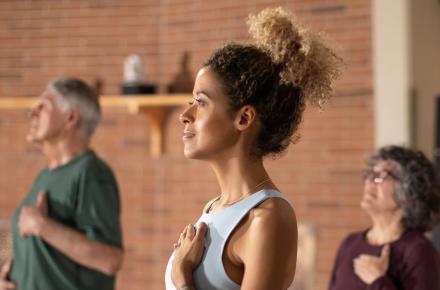The Heart and Soul of Science in Yoga

As a yoga teacher, with 18 years of teaching experience, a yoga therapist, who has studied extensively the teachings and application of yoga to promote health and wellbeing of all people, and a scientist trained in using the scientific method to study the true nature of things, I am passionate about the intersection of yoga and science. I’d like to share with you my why for this passion.
The traditional teachings of yoga and modern science both have an aim to understand the truth. The philosophy of yoga indicates that at the root of all suffering is ignorance (avidya) and correct knowledge (vidya) is the antidote to suffering. By increasing our understanding of how, why and for whom yoga techniques have benefit we can more effectively practice and teach the vast array of yoga tools without unintentionally creating harm and increasing suffering.
The modern scientific method offers us an approach to studying the application of yoga in a way that can enable the teachings of yoga to reach and benefit a wider array of individuals than they have historically, while embracing the ethics of ahimsa (non-harming) and satya (truthfulness).
The traditional teachings of yoga have evolved over time based on the direct experience of the practitioners. Those practitioners then passed on teachings to others, for most of the history of yoga this was through one-on-one instruction, and teachings were only provided when the teacher assessed that the student was ready. Yoga was a part of the culture in which the practitioners lived, and it appears was a practice based on philosophy that evolved throughout one’s life and study.
We know from the traditional teachings some of the effects that those practitioners experienced, with commitment to long-term practice, self-study and personalized teaching. Does that mean that all people will experience the same effects? How does learning in a group setting as an older adult for example affect the experience? How does someone’s experience differ if they are from a culture not typically represented in main-stream yoga? What practices are safe and beneficial for those experiencing chronic or acute health conditions?
These questions, among many, many more are the types of questions that as they are answered enable the teaching of yoga to reach diverse populations while embodying ahimsa and satya in the teachings.
Modern areas of increased knowledge are helping to expand the application of yoga safely to populations that have not traditionally received the benefits of the practice. Some of the populations benefiting from this expanded understanding include veterans, people living with chronic pain, chronic disease and mental health conditions, trauma survivors and those experiencing the effects of chronic stress (e.g. related to race, economic status, work conditions etc.).
The research is based on and informed by the tradition of yoga, while also incorporating a modern understanding of anatomy, physiology, mental health, disease processes and the intersection of social influences such as culture, race, and age. Most studies currently being conducted on the application of yoga, include protocols that incorporate pranayama (breath practices), asana (physical practices) and meditation. These protocols are designed and adapted based on the expertise of yoga teachers and yoga therapists that bring clinical experience working with specific populations to the programs.
Increasingly, headlines are emphasizing the research findings around the benefits of yoga. But you might ask yourself what styles and techniques were studied? How do the findings relate to your own practice or your teaching? What classes or teachers should you recommend to your loved ones? Can this research help reduce suffering, your own or others, or increase the understanding of yoga?
I hope if you love yoga and believe it can benefit more people than those who are currently practicing, that you get curious around some of these questions.
















































